How Thick are Manufactured Home Walls?

Want to know how thick are manufactured home walls? Learn about Clayton home wall insulation, stud size and more.
Each Clayton Built® home is constructed inside one of our climate controlled home building facilities with quality, brand name materials. Our homes are built with strength and durability for your family to enjoy for a lifetime and to ensure each one meets national building standards.
How thick are manufactured home exterior walls?
Our exterior walls are most frequently constructed with standard 2x4” studs, but they could also be constructed with 2x3” or 2x6” studs depending on a variety of factors such as:
- Home site thermal zone
- Home site wind zone
- Price point of your home
How does that compare to site built homes?
Site built home studs will vary by state and local building code requirements as well as the home builder who’s constructing the home. Since different state and local governments have different building requirements, it can vary by type of code in place. But let’s take a look at a couple of examples.
North Carolina has a rule that if load bearing wall studs are spaced at a maximum of 24” apart, and are at a height of 10 ft. or less supporting just a roof, the studs should be a minimum of 2x4” studs.¹ Additional home floors like a habitable attic or second floor require thicker wall studs for site built homes in North Carolina.
The State of Oregon uses the same rule and requires that if load bearing wall studs are spaced at 24” apart, are at a height of 10ft. or less and support just a roof, the studs can be 2x4” or greater in thickness.²
How thick are manufactured home wallboards?
Another important factor for wall thickness is the wallboard used in your home. Manufactured home wallboards range in thickness from 5/16” to ½”. The 5/16” thickness used to be the most popular measurement for Paper On Gypsum (POG) wallboards, but the majority of new Clayton homes with POG wallboards are now 3/8”.
When it comes to finished drywall wallboards, you’ll find either 3/8” or ½” options in Clayton manufactured homes built at home building facilities where finished drywall is an available option.
Manufactured Home Exterior Wall Insulation
Other manufactured home wall materials include wall insulation. Manufactured homes from the past often had exterior walls with 2x3” studs and minimal insulation, but new Clayton Built® homes have come a long way to improve quality in the last 15 years.
All our exterior walls are fully insulated to ensure that your home will meet or exceed R-value HUD requirements determined by your particular climate zone. “R-value” is the amount of resistance to heat flow through insulation. This means the higher the R-value, the greater the resistance to heat transfer.
A lower heat transfer because of proper insulation in your new manufactured home means the climate inside of your home will stay more consistent all year. Plus, you’ll likely have lower energy costs because the insulation lets less heat escape in the winter and less heat seep in during the summer.
If you choose to upgrade your wall studs to a larger size for greater manufactured home wall thickness, it allows a higher R-Value insulation. A thicker mobile home wall means even more insulation can be packed into the wall. This smart, valuable choice increases your energy savings and makes your home more comfortable all year long.
How thick are manufactured home interior walls?
Per HUD Code, our interior wall studs are typically constructed with 2x3” or 2x4” lumber and spaced at 16” or 24”.³ These studs are framed on 16” or 24” centers with door and window openings that have structural headers for functionality and additional strength.
How does that compare against site built home construction?
Again, each state’s building requirements vary, but let’s look at the current wood wall stud requirements in North Carolina and Oregon to see an example.
In both North Carolina and Oregon, interior walls that are not load bearing require a minimum of 2x3” wall studs at stud heights of 10 feet or less with a spacing of 16” or less.¹ A minimum thickness of 2x4” wall studs should be used at stud heights of 14 feet or less with a spacing of 24” or less.¹ These requirements are comparable to current Clayton wall construction standards!
Other Manufactured Home Interior Wall Components
Since there is electrical wiring passing through the wall studs in multiple areas, our manufactured home walls also contain steel plates to prevent damage and ensure safety. We follow building requirements stating electrical wiring will never pass through the same hole as piping to further ensure home safety.³
After interior walls are in position, they are packed with quality insulation for energy efficiency. They will be finished with a variety of wall materials.
If you’re looking at older mobile homes, you’re likely to find Vinyl on Gypsum (VOG) wallboards, and most new manufactured homes have either Paper on Gypsum (POG) wallboard or finished drywall options.
So, how safe are manufactured home walls?
As far as the thickness of the walls inside a Clayton Built® manufactured home, all studs meet or exceed federal standards in moisture content and overall quality, providing an exceptional amount of wall thickness in your manufactured home.
For example, each home is built for a designated wind zone, and wall systems, including the wall studs, must be designed to resist wind pressures and wind loads for the final destination of the home.³ All the walls in a manufactured home must also be able to support all the material used to enclose the manufactured home.³
Additionally, all structural components in a manufactured home wall system must be able to resist highway elements during transportation, which requires watertight construction and a home capable of resisting vibration forces.³ And as we already stated, we make sure to follow building requirements for electrical wiring safety!
Our building process for Clayton Built® manufactured homes is precise and streamlined. We take pride in our homes, down to the wall system, and we want you to do the same. Better studs mean doors and windows that operate and latch smoothly, walls that are straight and a home that looks great.
You’ll find quality manufactured home construction materials throughout every Clayton Built® home. Visit a home center near you and walk through a fully furnished manufactured home today!
- North Carolina State Building Code: Residential Code. PDF. Country Club Hills, Illinois: International Code Council, 2012.
- 2017 Oregon Residential Specialty Code. PDF. Country Club Hills, Illinois: International Code Council, 2017.
- 24 CFR Part 3280: Manufactured Home Construction and Safety Standards with Interpretive Bulletins. Department of Housing and Urban Development, March 7, 2016.
Are you ready to find your dream home?
Start shopping now or find a home center in your area to learn more about Clayton Built® home options.By entering your email address, you agree to receive marketing emails from Clayton. Unsubscribe anytime.
© 1998-2025 Clayton.




